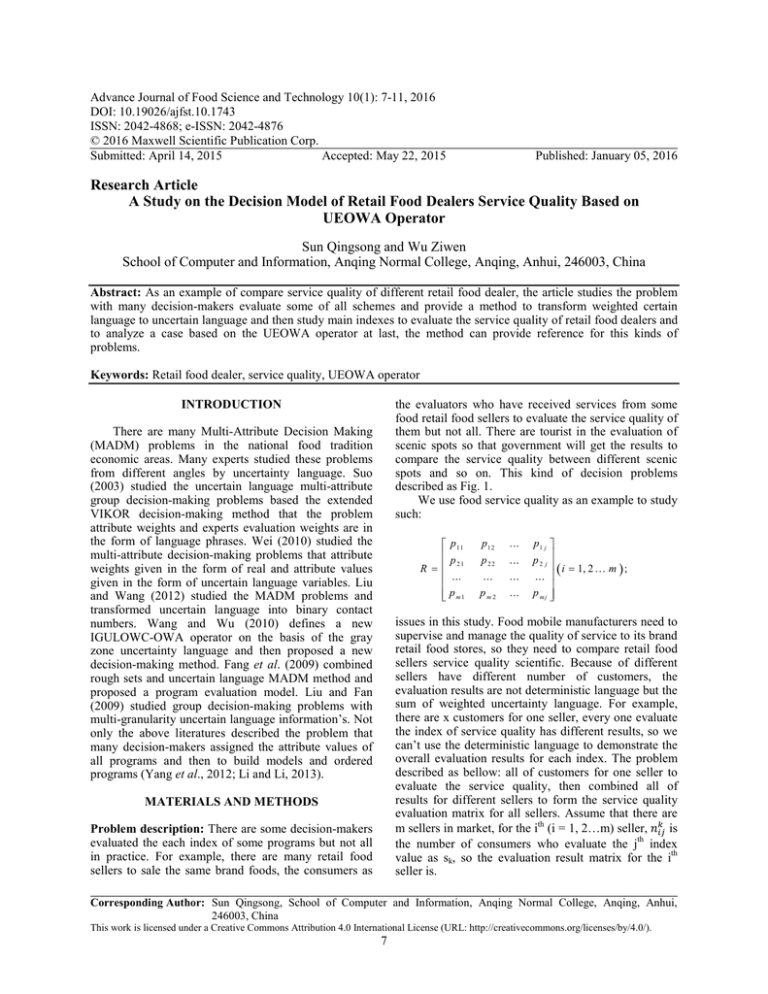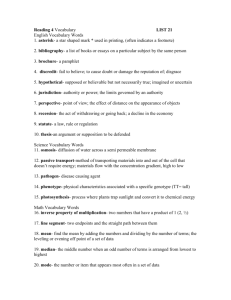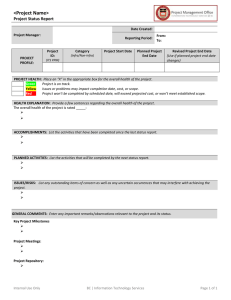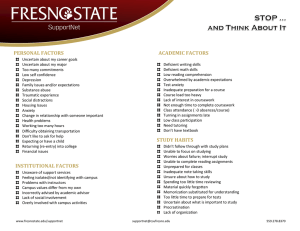Advance Journal of Food Science and Technology 10(1): 7-11, 2016
advertisement

Advance Journal of Food Science and Technology 10(1): 7-11, 2016
DOI: 10.19026/ajfst.10.1743
ISSN: 2042-4868; e-ISSN: 2042-4876
© 2016 Maxwell Scientific Publication Corp.
Submitted: April 14, 2015
Accepted: May 22, 2015
Published: January 05, 2016
Research Article
A Study on the Decision Model of Retail Food Dealers Service Quality Based on
UEOWA Operator
Sun Qingsong and Wu Ziwen
School of Computer and Information, Anqing Normal College, Anqing, Anhui, 246003, China
Abstract: As an example of compare service quality of different retail food dealer, the article studies the problem
with many decision-makers evaluate some of all schemes and provide a method to transform weighted certain
language to uncertain language and then study main indexes to evaluate the service quality of retail food dealers and
to analyze a case based on the UEOWA operator at last, the method can provide reference for this kinds of
problems.
Keywords: Retail food dealer, service quality, UEOWA operator
the evaluators who have received services from some
food retail food sellers to evaluate the service quality of
them but not all. There are tourist in the evaluation of
scenic spots so that government will get the results to
compare the service quality between different scenic
spots and so on. This kind of decision problems
described as Fig. 1.
We use food service quality as an example to study
such:
INTRODUCTION
There are many Multi-Attribute Decision Making
(MADM) problems in the national food tradition
economic areas. Many experts studied these problems
from different angles by uncertainty language. Suo
(2003) studied the uncertain language multi-attribute
group decision-making problems based the extended
VIKOR decision-making method that the problem
attribute weights and experts evaluation weights are in
the form of language phrases. Wei (2010) studied the
multi-attribute decision-making problems that attribute
weights given in the form of real and attribute values
given in the form of uncertain language variables. Liu
and Wang (2012) studied the MADM problems and
transformed uncertain language into binary contact
numbers. Wang and Wu (2010) defines a new
IGULOWC-OWA operator on the basis of the gray
zone uncertainty language and then proposed a new
decision-making method. Fang et al. (2009) combined
rough sets and uncertain language MADM method and
proposed a program evaluation model. Liu and Fan
(2009) studied group decision-making problems with
multi-granularity uncertain language information’s. Not
only the above literatures described the problem that
many decision-makers assigned the attribute values of
all programs and then to build models and ordered
programs (Yang et al., 2012; Li and Li, 2013).
p 11
p
21
R =
...
p m 1
p12
...
p 22
...
...
...
pm2
. ..
p1 j
p 2 j
( i = 1, 2 … m ) ;
...
p m j
issues in this study. Food mobile manufacturers need to
supervise and manage the quality of service to its brand
retail food stores, so they need to compare retail food
sellers service quality scientific. Because of different
sellers have different number of customers, the
evaluation results are not deterministic language but the
sum of weighted uncertainty language. For example,
there are x customers for one seller, every one evaluate
the index of service quality has different results, so we
can’t use the deterministic language to demonstrate the
overall evaluation results for each index. The problem
described as bellow: all of customers for one seller to
evaluate the service quality, then combined all of
results for different sellers to form the service quality
evaluation matrix for all sellers. Assume that there are
is
m sellers in market, for the ith (i = 1, 2…m) seller, th
the number of consumers who evaluate the j index
value as sk, so the evaluation result matrix for the ith
seller is.
MATERIALS AND METHODS
Problem description: There are some decision-makers
evaluated the each index of some programs but not all
in practice. For example, there are many retail food
sellers to sale the same brand foods, the consumers as
Corresponding Author: Sun Qingsong, School of Computer and Information, Anqing Normal College, Anqing, Anhui,
246003, China
This work is licensed under a Creative Commons Attribution 4.0 International License (URL: http://creativecommons.org/licenses/by/4.0/).
7
Adv. J. Food Sci. Technol., 10(1): 7-11, 2016
Fig. 1: Decision problems
So the evaluation results of jth index by all
consumers record as the sum of weighted deterministic
language as follow:
n i01
1
n i1
.. .
k
n i 1
Pij = nij0 s0 + nij1 s1 + nij2 s2 + nij3 s3 + ... + nijk sk
n i02
n i12
...
...
.. .
n ik2
...
...
n ij0
n i1j
k
n i j
k is the number of index and the number of
consumers is ni = + + …… + ; pij = Pij/ni; pij
th
is the weighted mean of the j index value that evaluate
by all the consumers for ith seller, so we constructed the
service quality evaluation matrix R of all the retail food
sellers by consumers as follow.
Consumers evaluation results is sj, so the total
evaluation value of k+l consumers is s(ki+lj)/(k+l), it is
between si and sj, we assumed ksi + ls j = s( ki + lj ) /( k + l ) ,
Basic knowledge: Two-tuple linguistic information is
reprints by tuple group (sk, α) that show the results for
evaluation objects. sk is the element of properties
language assessment scale set.
S = {very bad, bad, few bad, normal, few good,
good, very good }={ s1, s2, s3, s4, s5, s6, s7}.
S has some properties as follows:
Property 1: If k consumers evaluate one index value as
si, so the overall index value is si and we can deem ksi is
equivalent to si, record as ksi == si.
•
•
•
when j< = i, j ≤ ki + lj ≤ i .
k +l
Property 2: Extended to the entire expand scale:
k1 si + k 2 s j + ...... + k x s h == s k1si + k 2 s j +...... + k x sh
k1 + k 2 + ....... k x
Order: when i> = j, si> = sj
Inverse operator: Neg (si) = sj, j = L-I, L+1 is the
Element number of language set (S)
Maximation operation and minimization operation:
when si> = sj, min {si, sj} = sj
−
si , s j , sk ∈ S
Definition 2: Order int is the rounding operator, int
(⋯ ) is the integer part of ⋯ .
In order to avoid loss decision-making information
and calculation, we defined a extended scale =
{si,|s1≤si≤st, t ∈ [1, t]}, which was based on original
scale S = {si|i = 1, 2, 3 …q}. t is a sufficiently large
positive number, if i ∈ {1, 2, 3 … q}, we called si is
primitive term, otherwise, si is expand term. Decision
makers use primitive term to evaluate programs usually,
but use expand term in the procedure of calculation and
order.
If = [sa, sβ], sa, sβ ∈ , sa and sβ showed lower
limit and upper limit especially and defined as the sets
of all the uncertainty language variables.
⋯
⋯
Definition 3: Assumed sa is belong to extended scale
and a is a real number between 1 and t. if a is a integer,
sa is expressed as uncertainty language [sa, sa]; but if a is
not a integer, sa is expressed as uncertainty language
[int (a), int (a) +1] according to definition 2.
Definition 4: For any two uncertain linguistic
variables:
:
:
−
u = [sa , sb ], v = [ sc , sd ] ∈ S , β , β1 , β 2 ∈ [0,1]
Definition 1: On the basis of the ordering of language
evaluation scale, if k consumers evaluation results
is si, l:
The operation rule was defined as follows:
8
Adv. J. Food Sci. Technol., 10(1): 7-11, 2016
:
•
:
RESULTS AND DISCUSSION
u ⊕ v = [ s a , sb ] ⊕ [ s c , s d ] = [ s a ⊕ sc , sb ⊕ s d ]
= [ s a + c , sb + d ];
Evaluation indexes of retail food sellers service
quality: This study from the consumers perspective to
study most concerned factors When they accepting food
dealers service, as index of the decision-making model.
The first index is Service Environment (SE) which
is the rest place provided by food dealers who provide
computers for customers to access entertainment and
fine magazines and the place whether bring a relaxed
atmosphere for customers will to enhance customers
feeling because of the good service environment.
Second index is the Service Attitude (SA) refers to
the workers have mild manners, respect and
enthusiastic, active, etc. or not in the process of provide
services to consumers, rather than passed individual
negative emotions to customers. If service attitude is
better, the customer will feel better and the possibility
will greater for accept service again.
Third index is Maintenance Quality (MQ), after
consumers receive the services, whether there will be
some problems make customers feel the quality is not
high, such as the consumers to shop for air cleaning
work, they find the food air-conditioning still smell
after the completion of the service. This situation will
make consumers feel poor quality of service.
Fourth index is Service Professionalism (SP), the
staff need explain the technology problem and
questions to customers professional and easy to
understand.
Fifth index is Work Efficiency (WE), it is refers to
response time is or not fast when consumers need
service for example, maintenance staff should arrive at
the position when consumer’s food broke down as soon
as possible.
Sixth index is food Cleanliness (VC) that means
after complete food mobile maintenance if the food
exterior and interior are kept clean or cause damage.
The last index is Expense (E). Generally, the better
the service, the costs are higher, but consumers want
lower prices to get higher service levels in a
competitive market, if the price is higher than the
average too much, even if the dealer offers the best
service will also affect consumers evaluation for the
overall quality of service.
:
•
β u = β [ s a , sb ] = [ β s a , β sb ] = [ s β a , s β b ];
•
u ⊕ v = v⊕ u;
•
β (u ⊕ v ) = β u ⊕ β v ;
•
( β1 + β 2 ) u = β1 u ⊕ β 2 u
:
:
:
:
:
:
:
:
:
:
:
~
~
~
Definition 5: Assumed u = [ s a , sb ], v = [ sc , s d ] ∈ S and
defined the possible degree of the formula
lab = b − a, lcd = d − c as follows:
when u~ ≥ v~ ; p(u~ ≥ v~ ) = max{1 − max( d − a ,0),0}
lab + lcd
when v~ ≥ u~ ; p (v~ ≥ u~ ) = max{1 − max( b − c ,0),0}
lab + lcd
Definition 6: Assumed = [sa, sb], = [sc, sd], = [se,
sf] ∈ there are some conclusions according to
definition 5 as follows:
:
:
:
:
•
0 ≤ p (u ≥ v) ≤ 1, 0 ≤ p (v ≥ u) ≤ 1.
•
When only d≤a, p (u ≥ v) = 0 p (u ≥ v) = 1
:
:
When only b≤c, p ( v ≥ u ) = 1
•
When only b≤c; when only d≤a, p (v ≥ u ) = 0
•
•
p (u ≥ v) + p (v ≥ u) = 1, p (u ≥ u) = 1/ 2.
:
:
:
:
:
:
:
:
:
:
:
:
~
~
When only a + b≥c + d, p(u ≥ v) ≥ 1 / 2
:
:
When only a + b = c + d, p(u ≥ v) = 1/ 2
~
•
~
~
~
When p (u ≥ v) ≥ 1 / 2, p(v ≥ γ ) ≥ 1 / 2, there is a result
~
~
p(u ≥ γ ) ≥ 1 / 2
Definition 7: Assumed a function UEOWA: n → if
:
:
:
:
:
:
UEOWAw (u1 , u2 ..., un ) = w1 v1 ⊕ w2 v2 ⊕ ...... ⊕ wn vn,
w =
(w1, w2,…, wn) is the weighting vector associated with
function UEOWA , w ∈ [0,1]( j ∈ N ), n w = 1, u~ ∈ S~ , v~ is a
∑
j
j
i
Algorithm steps:
Step 1: Construct a weighted matrix.
Step 2: According the definitions 1, 2, 3 and properties
1 and 2 to transfer the evaluation of the
property value with certainty language to
property value by uncertain language and then
get a comprehensive decision matrix.
Step 3: According the definitions 5 to compare the
property value between different objects and
then build possible degree matrix.
Step 4: According the definitions 5 to calculate the
ordering vector V of possible degree matrix.
i
j =1
the jth bigger element in the group of uncertain
~
~
~
linguistic variables (u1 , u2 ..., un ) , we called function
UEOWA operator is a uncertain EOWA operator.
Definition 8: In the sort vector =
()
(
!
+
2− 1), n is the order of possible degree matrix, pij is
the element of the matrix.
9
Adv. J. Food Sci. Technol., 10(1): 7-11, 2016
Table 1: Transformed weighted certain language to extended term
SE
SA
MQ
A
S2.698
S1.061
S3.753
B
S3.027
S4.027
S3.481
C
S2.990
S3.995
S5.296
D
S4.437
S2.772
S4.727
SP
s4.061
S4.518
S3.990
S5.545
:
:
:
:
E
S1.164
S3.407
S1.587
S2.965
:
:
:
z A ( w) = UEOWAw (u1 , u2 ..., un ) = 0.1× [ s5 , s6 ] ⊕ 0.13 × [ s4 , s5 ]
⊕0.19 × [s3 , s4 ] ⊕ 0.23 × [ s2 , s3 ] ⊕ 0.15 × [ s2 , s3 ] ⊕ 0.08 × [s1 , s2 ]
⊕0.12 × [s1 , s2 ] = [ s2.55 , s3.55 ]
:
z d ( w )( d ∈ N ) : z d ( w ) = UEOWAw (u1 , u 2 ,..., u n )
:
:
:
:
z B (w) = UEOWAw (u1 , u2 ..., un ) = 0.1× [s5 , s6 ] ⊕ 0.13 × [s4 , s5 ] ⊕
0.19 × [ s4 , s5 ] ⊕ 0.23 × [ s3 , s4 ] ⊕ 0.15 × [s3 , s4 ] ⊕ 0.08 × [s3 , s4 ]
Step 7: According definition 5 to reuse the possible
degree formula to calculate the possible degree
&'( ()) between the comprehensive attribute
value of different schemes and build
complementarily matrix of possible degree.
Step 8: Get the vector of possible degree and sorted
according definition 8, we get a result which
object is best.
⊕0.12 × [ s3 , s4 ] = [ s3.52 , s4.52 ]
:
:
:
:
z C (w) = UEOWAw (u1 , u2 ..., un ) = 0.1× [s5 , s6 ] ⊕ 0.13 × [s5 , s6 ]
⊕0.19 × [ s4 , s5 ] ⊕ 0.23 × [ s3 , s4 ] ⊕ 0.15 × [s3 , s4 ] ⊕ 0.08 × [ s2 , s3 ]
⊕0.12 × [ s1 , s2 ] = [s3.33 , s4.33 ]
:
:
:
:
z D (w) = UEOWAw (u1 , u2 ..., un ) = 0.1× [s5 , s6 ] ⊕ 0.13 × [ s5 , s6 ]
Case study: A food manufacture in order to assess the
service quality of four different retail food dealers and
collect some results that there are 146, 108, 206 and
176, respectively consumers to evaluate the quality in
the same time period respectively, we accord step 1 and
2 to get Table 1 and a comprehensive matrix that
described by uncertain language:
[s2 , s3 ]
[s , s ]
3 4
[s2 , s3 ]
[s4 , s5 ]
VC
s5.342
S5.083
S5.631
S5.056
And according step 5 and 6 to calculate the
comprehensive evaluation values of attributes for these
four decision schemes, as follows:
Step 5: According the vector components to descend
order by uncertain linguistic properties of each
program in the decision matrix.
Step 6: According 7 to use UEOWA operator and
weighted vector to assemble uncertain linguistic
attribute values which was sorted and obtain a
comprehensive attribute value of the scheme d:
:
WE
S2.239
S3.472
S4.228
S3.852
⊕0.19 × [ s4 , s5 ] ⊕ 0.23 × [ s4 , s5 ] ⊕ 0.15 × [s3 , s4 ] ⊕ 0.08 × [s2 , s3 ]
⊕0.12 × [ s2 , s3 ] = [s3.68 , s4.68 ]
And then according step 7 to use the formula of
possible degree to calculate the possible degree matrix
between different attribute values of four schemes and
get a result as follow:
[s1, s2 ] [s3 , s4 ] [s4 , s5 ] [s2 , s3 ] [s5 , s6 ] [s1, s2 ]
[s4 , s5 ] [s3 , s4 ] [s4 , s5 ] [s3 , s4 ] [s5 , s6 ] [s3 , s4 ]
[s3 , s4 ] [s5 , s6 ] [s3 , s4 ] [s4 , s5 ] [s5 , s6 ] [s1, s2 ]
[s2 , s3 ] [s4 , s5 ] [s5 , s6 ] [s3 , s4 ] [s5 , s6 ] [s2 , s3 ]
0
0.5 0.015 0.11
0.985 0.5 0.595 0.42
0.89 0.405 0.5 0.325
0.58 0.675 0.5
1
According to step 3 and 4, we get ordering vectors
of possible degree as follows:
At last, according step 4 to calculate the ordering
vector of possible degree V = (0.1354, 0.2917, 0.1767,
0.2296) and then get the result Bf Df Cf A, sorted by
vector component, so the best one in these food dealers
is B.
V1 = (0.131, 0.083, 0.166, 0.196, 0.107, 0.214,
0.083)
V2 = (0.060, 0.179, 0.107, 0.179, 0.107, 0.214,
0.107)
CONCLUSION
We accorded the practical problems that many
decision makers are not to evaluate all schemes and
there are different numbers of decision makers to
evaluate each scheme and based on the certainty of
attribute values that evaluated by decision makers, to
expressed the attribute values of total schemes to the
sum of weighted certain language and then raised a new
method that transformed the weighted certain language
to uncertain language and combined possible degree to
compared the service quality between different retail
V3 = (0.095, 0.131, 0.202, 0.131, 0.166, 0.202,
0.071)
V4 = (0.155, 0.083, 0.155, 0.202, 0.119, 0.202,
0.083)
Assumed weighted vector:
W = (0.10, 0.13, 0.19, 0.23, 0.15, 0.08, 0.12)
10
Adv. J. Food Sci. Technol., 10(1): 7-11, 2016
Liu, W.F. and D.X. Wang, 2012. An uncertain
linguistic multi-attribute decision-making model
based on binary connection number distance. Math.
Pract. Theory, 42: 148-152.
Suo, W.L., 2003. Method for uncertain linguistic
multiple attribute group decision making based on
extended VIKOR. J. Cont. Decis., 28: 1431-1435.
Wang, J.Q. and J.W. Wu, 2010. Multi-criteria decisionmaking approach based on the interval grey
uncertain linguistic. Chinese J. Manag. Sci., 18:
107-111.
Wei, G.W., 2010. Method of uncertain linguistic
multiple attribute group decision making based on
dependent aggregation operators. J. Syst. Eng.
Electron., 32: 764-768.
Yang, X., S.H. Teng and W. Zhang, 2012. Evaluating
real estate based on two-tuple linguistic multiattribute decision making. Appl. Res. Comp., 27:
2565-2566.
food dealers that based on UEOWA operator and the
method can be provided some consults for this kind of
multiple attribute problems.
REFERENCES
Fang, H., J.R. Tan and G.F. Yin, 2009. Design scheme
evaluation based on improved uncertain-language
multi-attribute decision-making method. Comp.
Integ. Manuf. Syst., 15: 1257-1261.
Li, J.P. and W. Li, 2013. TOPSIS algorithm for ordinal
multi-attribute decision making with incomplete
weight information. Comp. Integ. Manuf. Syst., 19:
1408-1413.
Liu, Y. and Z.P. Fan, 2009. A group decision-making
method with multi-granularity uncertain linguistic
information. J. Northeastern Univ Nat. Sci., 30:
601-604.
11






